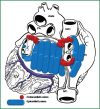Minimally invasive surgery for atrial fibrillation
- PMID: 24251031
- PMCID: PMC3831834
- DOI: 10.3978/j.issn.2072-1439.2013.10.17
Minimally invasive surgery for atrial fibrillation
Abstract
Atrial fibrillation (AF) remains the most common cardiac arrhythmia, affecting nearly 2% of the general population worldwide. Minimally invasive surgical ablation remains one of the most dynamically evolving fields of modern cardiac surgery. While there are more than a dozen issues driving this development, two seem to play the most important role: first, there is lack of evidence supporting percutaneous catheter based approach to treat patients with persistent and long-standing persistent AF. Paucity of this data offers surgical community unparalleled opportunity to challenge guidelines and change indications for surgical intervention. Large, multicenter prospective clinical studies are therefore of utmost importance, as well as honest, clear data reporting. Second, a collaborative methodology started a long-awaited debate on a Heart Team approach to AF, similar to the debate on coronary artery disease and transcatheter valves. Appropriate patient selection and tailored treatment options will most certainly result in better outcomes and patient satisfaction, coupled with appropriate use of always-limited institutional resources. The aim of this review, unlike other reviews of minimally invasive surgical ablation, is to present medical professionals with two distinctly different, approaches. The first one is purely surgical, Standalone surgical isolation of the pulmonary veins using bipolar energy source with concomitant amputation of the left atrial appendage-a method of choice in one of the most important clinical trials on AF-The Atrial Fibrillation Catheter Ablation Versus Surgical Ablation Treatment (FAST) Trial. The second one represents the most complex approach to this problem: a multidisciplinary, combined effort of a cardiac surgeon and electrophysiologist. The Convergent Procedure, which includes both endocardial and epicardial unipolar ablation bonds together minimally invasive endoscopic surgery with electroanatomical mapping, to deliver best of the two worlds. One goal remains: to help those in urgent need for everlasting relief.
Keywords: Ablation; Atrial Fibrillation; Minimally invasive surgery.
Figures






References
-
- Jahangir A, Lee V, Friedman PA, et al. Long-term progression and outcomes with aging in patients with lone atrial fibrillation: a 30-year follow-up study. Circulation 2007;115:3050-6 - PubMed
-
- Chugh SS, Blackshear JL, Shen WK, et al. Epidemiology and natural history of atrial fibrillation: clinical implications. J Am Coll Cardiol 2001;37:371-8 - PubMed
-
- Benjamin EJ, Wolf PA, D'Agostino RB, et al. Impact of atrial fibrillation on the risk of death: the Framingham Heart Study. Circulation 1998;98:946-52 - PubMed
-
- Connolly SJ, Camm AJ, Halperin JL, et al. Dronedarone in high-risk permanent atrial fibrillation. N Engl J Med 2011;365:2268-76 - PubMed
Publication types
LinkOut - more resources
Full Text Sources
